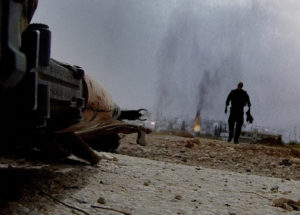In the last week alone, more than 10,000 Syrian civilians have fled the fighting in the ISIS-held areas of Hajin enclave in Deir ez-Zor governorate in northeast Syria for Al-Hol camp in the Syrian Kurdish YPG-controlled Hassakeh region. Those fleeing this last ISIS enclave — a sliver of land along the Euphrates River — report that civilian casualties are widespread. Food and medical supplies are non-existent, and civilian infrastructure has been completely leveled. Families that have managed to escape the fighting say that ISIS is preventing other civilians from leaving the besieged area.
Since fighting escalated in December — right around the time President Trump decreed that ISIS had been completely wiped out — more than 23,000 internally displaced peoples (IDPs) have made the journey from Hajin to Al Hol, effectively tripling the camp’s population and stretching it far beyond capacity. The number of IDPs and casualties is expected to rise dramatically in the coming weeks.
According to Dr. Hussam Al Fakir, Chairman of the Union of Medical Care and Relief Organizations, the journey of the IDPs is horrendous: “They are mostly women and children, escaping the horrors of [ISIS] if they are so lucky, facing indiscriminate airstrikes, crossing minefields and checkpoints in the freezing cold. They need every support possible to survive the journey.” Many die of hypothermia or starvation along the way.
These civilians make the harrowing journey at night, in the bitter cold, often wading through minefields and open fighting. UNHCR reports that, since December, more than 35 children and infants have died from hypothermia and malnourishment on this terrifying trek. Despite the grueling journey, once they reach the Kurdish-controlled territory, the civilians — mostly women and children — are herded into open trucks and have to endure another agonizing journey northward to Al Hol camp, fully exposed to the blistering cold of winter. Little assistance is provided to these hungry and freezing people on their journey, and medical facilities in Hassakeh town — where the most critical cases from the camp are referred—are overstretched caring for acutely malnourished children.
What can be done?
Humanitarian actors are collectively demanding the establishment of a protected corridor to ensure safe passage of IDPs along the 250 km route from Hajin to Al Hol, as well as emergency medical transit sites en route, where food, water, warm clothing, and life-saving assistance can be provided. This initiative has remained unimplemented as violence intensifies.
While Washington rushes to wrap things up with ISIS, claiming victory so the ill-advised withdrawal can commence, civilians are once again bearing the brunt of the recent uptick in clashes between US-supported Kurdish forces and the remaining ISIS fighters. The United States must protect these people caught in the crosshairs, despite the urgency it may feel to eviscerate remnants of ISIS by any means necessary. The Trump Administration must take the lead in ensuring that this humanitarian corridor and transit centers are established. Failure to take these measures will cause immense suffering to civilians who are just trying to stay alive as the final battles with ISIS rage on.
Even if ISIS is effectively eradicated, that doesn’t mean the work is done. Without a political solution, the threat of ISIS’s resurgence looms large, which means there is no end in sight for the suffering of the Syrian people. One thing that is clear about terrorist groups: the greater the human suffering, the greater the opportunity for indoctrination and for replenishing their ranks.
Another endangered population: Syrian Kurds
Syrian civilians are not the only ones who will be affected by a premature and shortsighted withdrawal of US forces from Syria. Syrian Kurds are also endangered by this rash decision. The Kurdish-led Syrian Democratic Forces (SDF) and its people’s protection units (YPG) are responsible for liberating much of northeastern Syria from the Islamic State. The Syrian Kurds have been the primary ally in the U.S. and International Coalition’s efforts to eradicate radical Islam from Syria, but Washington’s untimely abandonment of its leadership role in Syria will undoubtedly put them in harm’s way.
Neighboring Turkey views the Syrian Kurdish fighters as terrorists affiliated with the Kurdistan Worker’s Party that it has been battling within its own borders. It has repeatedly threatened to launch a full-scale military offensive in northeastern Syria — the stronghold of the Syrian Democratic Council (the political arm of the SDF) as well as the location of Al-Hol camp, the very place where thousands of Syrian civilians are fleeing to for safety. Turkey has made clear it is “ready to strike” at a moment’s notice, with forces already assembled at the border. In addition to the Turkish threat, the Assad regime is trying to wrest back control of northeastern Syria, using Iranian proxy forces to do its bidding.
Trump’s abrupt announcement of his plans to withdraw US forces from Syria led to the resignation of Defense Secretary James Mattis and special presidential envoy for the collation to defeat the Islamic State, Brett McGurk, for good reason: they are two of the Kurds’ biggest allies in Washington and recognize the dangers that such a choice poses to the very existence of the Syrian Kurds.
The Kurds were relying on Washington’s assistance in reaching a political deal with President Assad before its withdrawal. The Kurds’ ultimate goal is “self-administration”: remaining a part of Syria but not under Assad’s control. According to Ilham Ahmed, the co-chair of the Syrian Democratic Council, the Kurds want the Assad regime to both acknowledge the administration of northeastern Syria and make fundamental changes to the Syrian Constitution. She is asking the U.S. to at least secure a “safe zone” for the Kurds before fully withdrawing, since the specter of U.S. withdrawal has rendered the Kurds especially vulnerable to their enemies.
It remains to be seen whether the U.S. or other coalition partners will stay engaged long enough to protect its Kurdish allies from possible extermination. One thing is clear: Turkey categorically cannot be charged with enforcing the buffer zone. The United States is reportedly trying to assemble a group of Western nations to do the job, but as of yet, not a single country has agreed to the proposal.
Trump has called Syria a place of “sand and death.” Premature withdrawal will make this all the more true — a self-fulfilling prophecy. The Syrian Kurds have suffered tremendously as they have done their part to realize an agenda very much shared by the United States. Northeastern Syria has been largely cut off from the rest of the world. The YPG has done its best to provide for civilians in the region, but fighting has been intense throughout the 8+ years of the civil war, and supplies and services have been scant, to put it mildly.
Recently, Jewish World Watch (JWW) hosted documentarian and activist River Hagg, who came to our offices to share his story of serving as a medic with the YPG. His documentary, The Volunteers, shook us to the core. It vividly brought to light the suffering of the Syrian Kurds in the war-beleaguered Northeast. Hagg warned us of the potential genocidal threat that the world’s abandonment would create for these people who have sacrificed so much to fulfill the Coalition’s agenda.
What Washington must give the Syrian Kurds now is time. Time to reach a political agreement. Time to convince Turkey not to attack the SDF/YPG. If it leaves its Syrian partners—led by the Kurds—vulnerable to attack by either the Syrian regime or neighboring Turkey, the ensuing conflict could have devastating humanitarian consequences and provide the Islamic State with the chance to reassemble. The Pentagon itself has warned that the group “could likely resurge in Syria within six to 12 months” if sustained pressure is not maintained. In addition to risking countless lives, US withdrawal now would create a vacuum that would catalyze international and regional conflict over power in Syria and leave room for Iran or Russia to move in.
Syria by the Numbers
- At least 220,000 civilians have died as a result of conflict since the civil war began in 2011 (Syrian Network for Human Rights)
- An estimated 13.1 million people are in need of humanitarian assistance (HNO)
 2 million are internally displaced (OCHA)
2 million are internally displaced (OCHA)- 6 million refugees have left the country, mostly to neighboring Lebanon, Turkey and Jordan (UNHCR)
- These two numbers together mean that nearly half of the population has been forcibly displaced from their homes, and many people have been displaced multiple times
- Children and youth comprise more than half of the displaced, as well as half of those in need of critical humanitarian assistance (ACT)
- in the last 8 years, Syria has been the country worst impacted in the world from explosive weapons (AOAV)
- Life expectancy in Syria dropped by over 20 years, while the number of physicians has decreased by at least 67.5% (AOAV)
- Syria’s GDP stands at half of its pre-conflict level
- Clearance of landmines and Explosive Remnants of War could take 50 years
- Half of the basic civilian infrastructure has been destroyed or rendered non-operational
- More than 45% of school-aged children in Syria no longer get an education


